Module 4 Unit 1 Let's make a home library.教案
文档属性
| 名称 | Module 4 Unit 1 Let's make a home library.教案 |
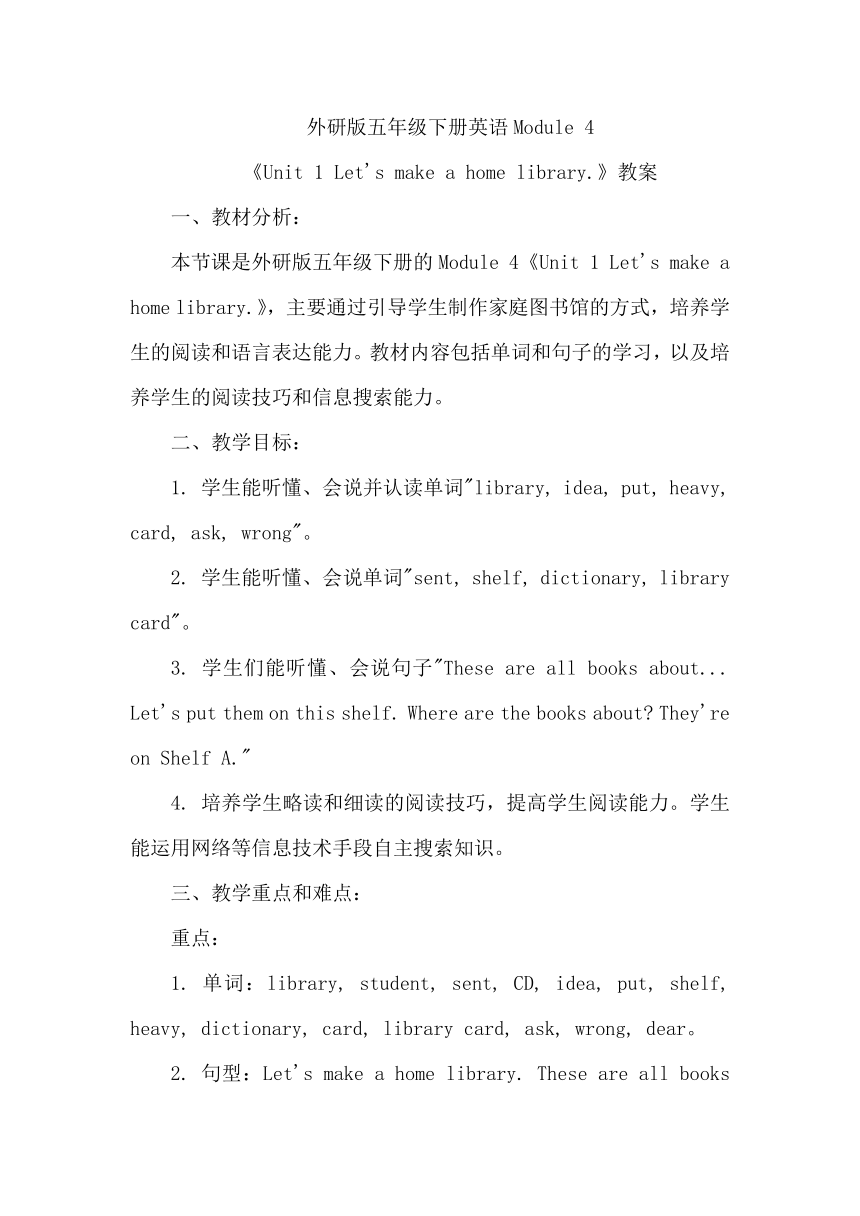
|
|
| 格式 | docx | ||
| 文件大小 | 15.6KB | ||
| 资源类型 | 教案 | ||
| 版本资源 | 外研版(三年级起点) | ||
| 科目 | 英语 | ||
| 更新时间 | 2024-03-24 16:48:03 | ||
图片预览

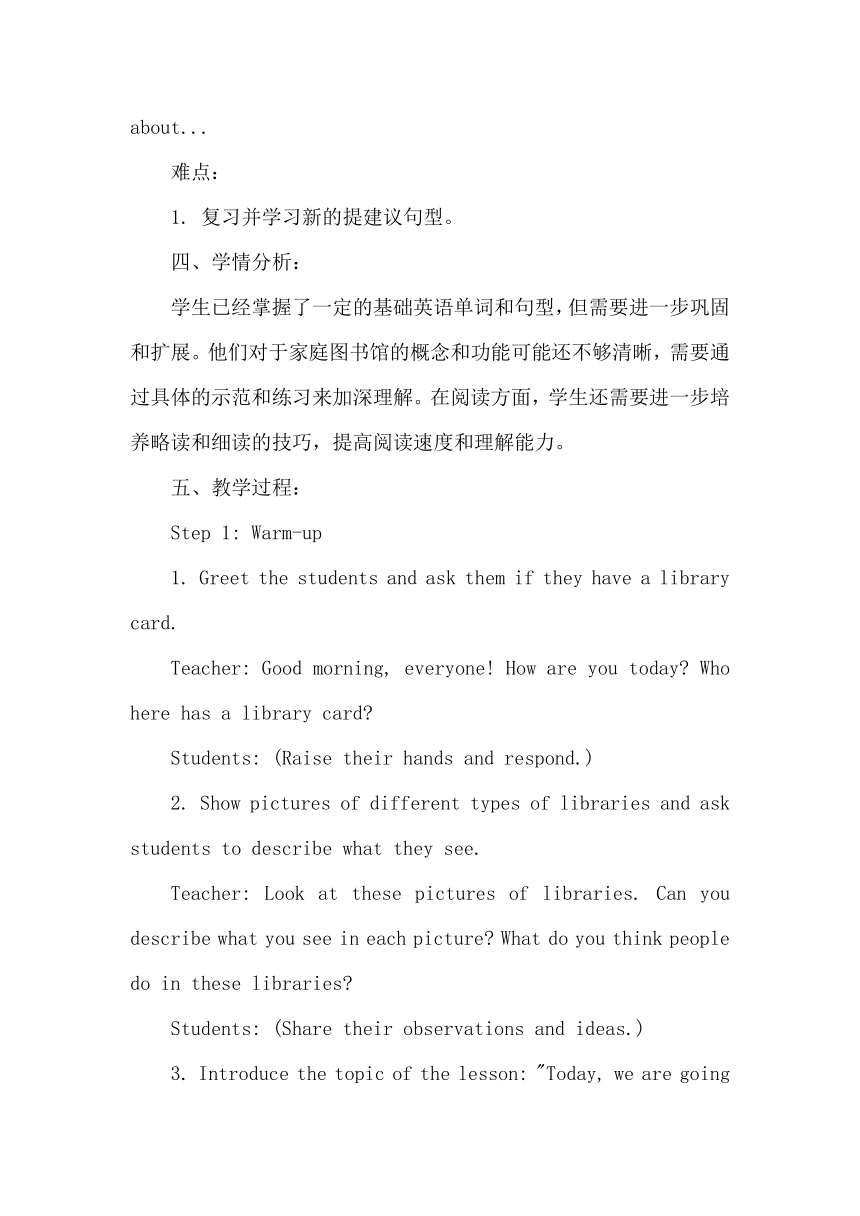
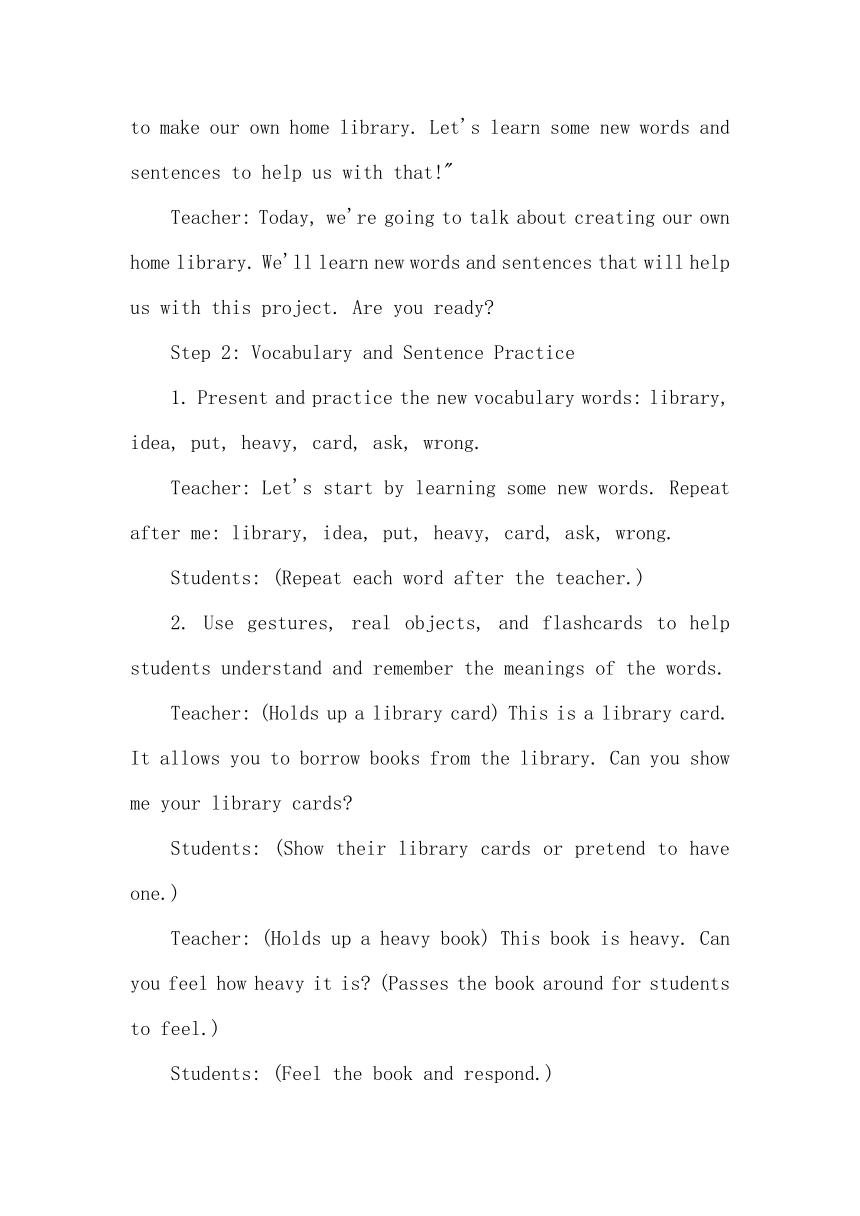
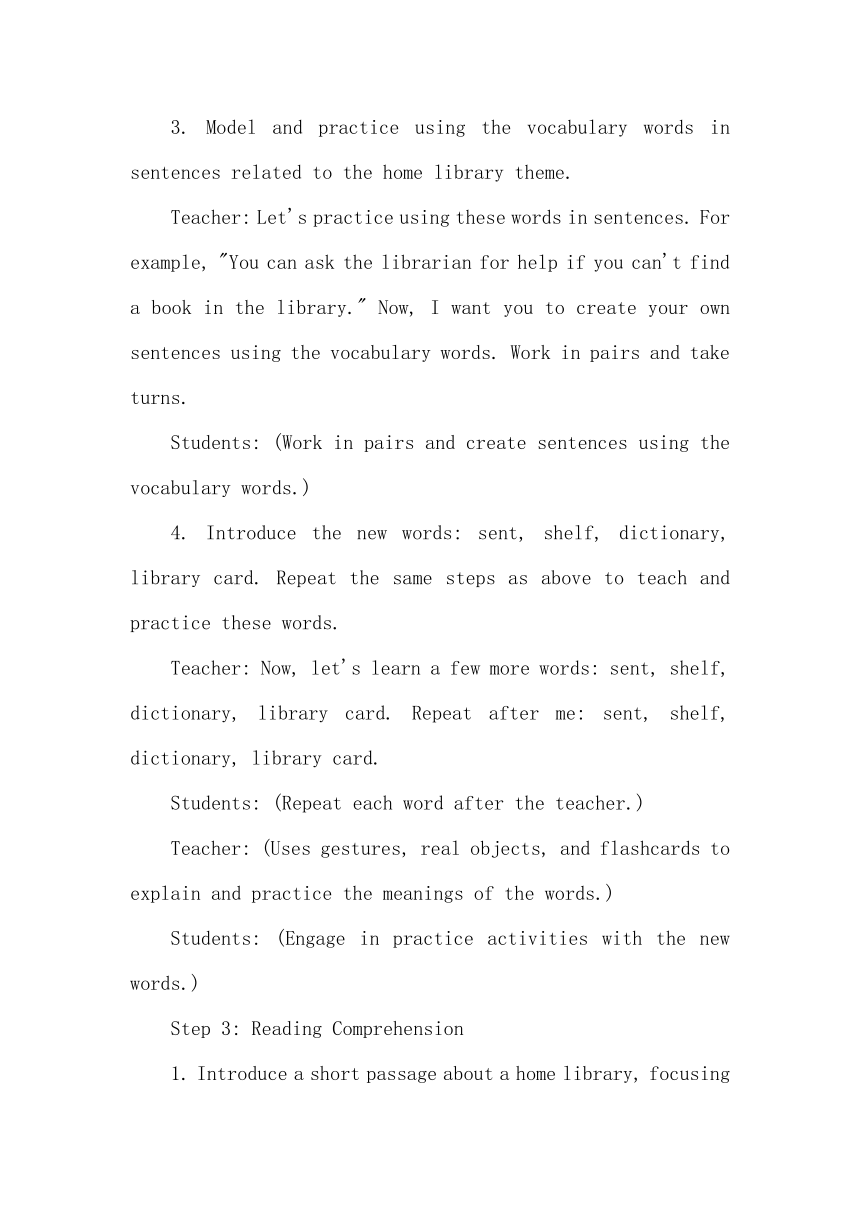
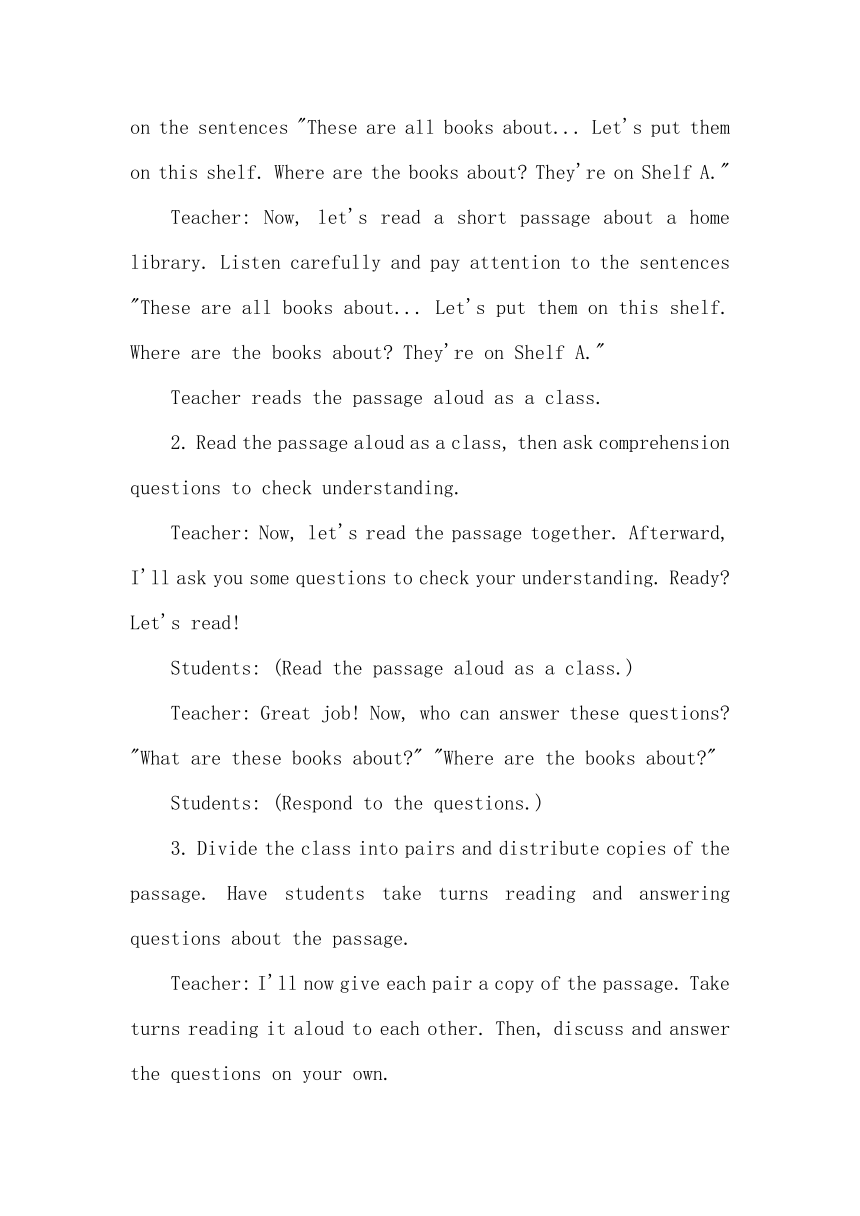
文档简介
外研版五年级下册英语Module 4
《Unit 1 Let's make a home library.》教案
一、教材分析:
本节课是外研版五年级下册的Module 4《Unit 1 Let's make a home library.》,主要通过引导学生制作家庭图书馆的方式,培养学生的阅读和语言表达能力。教材内容包括单词和句子的学习,以及培养学生的阅读技巧和信息搜索能力。
二、教学目标:
1. 学生能听懂、会说并认读单词"library, idea, put, heavy, card, ask, wrong"。
2. 学生能听懂、会说单词"sent, shelf, dictionary, library card"。
3. 学生们能听懂、会说句子"These are all books about... Let's put them on this shelf. Where are the books about They're on Shelf A."
4. 培养学生略读和细读的阅读技巧,提高学生阅读能力。学生能运用网络等信息技术手段自主搜索知识。
三、教学重点和难点:
重点:
1. 单词:library, student, sent, CD, idea, put, shelf, heavy, dictionary, card, library card, ask, wrong, dear。
2. 句型:Let's make a home library. These are all books about...
难点:
1. 复习并学习新的提建议句型。
四、学情分析:
学生已经掌握了一定的基础英语单词和句型,但需要进一步巩固和扩展。他们对于家庭图书馆的概念和功能可能还不够清晰,需要通过具体的示范和练习来加深理解。在阅读方面,学生还需要进一步培养略读和细读的技巧,提高阅读速度和理解能力。
五、教学过程:
Step 1: Warm-up
1. Greet the students and ask them if they have a library card.
Teacher: Good morning, everyone! How are you today Who here has a library card
Students: (Raise their hands and respond.)
2. Show pictures of different types of libraries and ask students to describe what they see.
Teacher: Look at these pictures of libraries. Can you describe what you see in each picture What do you think people do in these libraries
Students: (Share their observations and ideas.)
3. Introduce the topic of the lesson: "Today, we are going to make our own home library. Let's learn some new words and sentences to help us with that!"
Teacher: Today, we're going to talk about creating our own home library. We'll learn new words and sentences that will help us with this project. Are you ready
Step 2: Vocabulary and Sentence Practice
1. Present and practice the new vocabulary words: library, idea, put, heavy, card, ask, wrong.
Teacher: Let's start by learning some new words. Repeat after me: library, idea, put, heavy, card, ask, wrong.
Students: (Repeat each word after the teacher.)
2. Use gestures, real objects, and flashcards to help students understand and remember the meanings of the words.
Teacher: (Holds up a library card) This is a library card. It allows you to borrow books from the library. Can you show me your library cards
Students: (Show their library cards or pretend to have one.)
Teacher: (Holds up a heavy book) This book is heavy. Can you feel how heavy it is (Passes the book around for students to feel.)
Students: (Feel the book and respond.)
3. Model and practice using the vocabulary words in sentences related to the home library theme.
Teacher: Let's practice using these words in sentences. For example, "You can ask the librarian for help if you can't find a book in the library." Now, I want you to create your own sentences using the vocabulary words. Work in pairs and take turns.
Students: (Work in pairs and create sentences using the vocabulary words.)
4. Introduce the new words: sent, shelf, dictionary, library card. Repeat the same steps as above to teach and practice these words.
Teacher: Now, let's learn a few more words: sent, shelf, dictionary, library card. Repeat after me: sent, shelf, dictionary, library card.
Students: (Repeat each word after the teacher.)
Teacher: (Uses gestures, real objects, and flashcards to explain and practice the meanings of the words.)
Students: (Engage in practice activities with the new words.)
Step 3: Reading Comprehension
1. Introduce a short passage about a home library, focusing on the sentences "These are all books about... Let's put them on this shelf. Where are the books about They're on Shelf A."
Teacher: Now, let's read a short passage about a home library. Listen carefully and pay attention to the sentences "These are all books about... Let's put them on this shelf. Where are the books about They're on Shelf A."
Teacher reads the passage aloud as a class.
2. Read the passage aloud as a class, then ask comprehension questions to check understanding.
Teacher: Now, let's read the passage together. Afterward, I'll ask you some questions to check your understanding. Ready Let's read!
Students: (Read the passage aloud as a class.)
Teacher: Great job! Now, who can answer these questions "What are these books about " "Where are the books about "
Students: (Respond to the questions.)
3. Divide the class into pairs and distribute copies of the passage. Have students take turns reading and answering questions about the passage.
Teacher: I'll now give each pair a copy of the passage. Take turns reading it aloud to each other. Then, discuss and answer the questions on your own.
Students: (Read the passage and answer the questions in pairs.)
Step 4: Reading Skills and Information Searching
1. Explain the difference between skimming and scanning when reading.
Teacher: Now, let's talk about two important reading skills: skimming and scanning. Skimming means quickly looking through a text to get a general idea of what it's about. Scanning means searching for specific information in a text. These skills are helpful when we want to find information quickly.
2. Provide examples and demonstrate how to skim a text to get a general idea and scan for specific information.
Teacher: I'll show you an exampleof skimming. Look at this paragraph about a book. (Displays a paragraph on the board.) I'm going to quickly read through it to get a general idea of what the book is about. (Reads the paragraph quickly.) Based on my quick reading, I can tell that this book is about a girl who goes on an adventure.
3. Give students a short text about a specific topic related to books or libraries.
Teacher: Now, I'll give each of you a short text to read. These texts are about different topics related to books or libraries. Your task is to skim the text and answer the questions that follow. Remember, skimming means getting a general idea of what the text is about.
4. In pairs, have students practice skimming and scanning the text to answer questions about the topic.
Teacher: Get into pairs and take turns reading the text and answering the questions. Use your skimming and scanning skills to find the information you need.
Students: (Work in pairs, skim the text, and answer the questions.)
5. Introduce the concept of using technology to search for information. Show students how to use a search engine to find information about a specific book or author.
Teacher: Now, let's talk about using technology to search for information. Have you ever used a search engine to find information Today, I'll show you how to use a search engine to find information about a specific book or author. (Demonstrates a search on a search engine.) See how we can find reviews, summaries, and even author interviews It's a great way to learn more about a book or author.
Step 5: Group Activity Making a Home Library
1. Divide the class into small groups and assign each group a different topic or genre (e.g., science books, storybooks, history books).
Teacher: It's time for a fun group activity! I'm going to divide you into small groups. Each group will be assigned a different topic or genre for their home library. For example, one group will focus on science books, another on storybooks, and another on history books.
2. In their groups, students discuss and brainstorm ideas for books they would include in their home library based on the assigned topic.
Teacher: Now, in your groups, discuss and brainstorm ideas for books that you would include in your home library based on the assigned topic. Think about the books you enjoy and would like to have in your own library.
3. Each group presents their ideas to the class, using sentences like "We have chosen these books about science for our home library."
Teacher: Each group will now present their ideas to the class. Use sentences like "We have chosen these books about science for our home library." Be ready to explain why you chose those books and why they would be a great addition to your home library.
4. Encourage students to ask questions and make suggestions to other groups.
Teacher: As each group presents, I encourage you to ask questions and make suggestions to other groups. Let's create an interactive and supportive learning environment.
Step 6: Wrap-up and Reflection
1. Review the new vocabulary words and sentences learned in the lesson.
Teacher: Let's quickly review the new vocabulary words we learned today. Repeat after me: library, idea, put, heavy, card, ask, wrong, sent, shelf, dictionary, library card.
2. Have a brief discussion with the students about the importance of having a home library and the benefits of reading.
Teacher: Now, let's have a short discussion. Why do you think it's important to have a home library What are the benefits of reading Share your thoughts with the class.
3. Reflect on the learning process and ask students to share what they found most interesting or challenging about the lesson.
Teacher: Before we finish, I'd like to hear from each of you. What did you find most interesting or challenging about today's lesson Share your thoughts with the class.
六、板书设计:
[Library Vocabulary]
library, idea, put, heavy, card, ask, wrong
sent, shelf, dictionary, library card
[Sentences]
Let's make a home library.
These are all books about...
七、教学反思:
本节课通过引导学生制作家庭图书馆的方式,培养了学生的阅读和语言表达能力。在教学过程中,学生通过多种方式学习新的单词和句子,如图片、实物和闪卡,并进行了相关的练习。阅读方面,学生通过略读和细读的训练,提高了阅读技巧和理解能力。此外,通过小组活动,学生能够运用所学知识进行实际情境交流,提高了语言运用能力。在教学中,我注重了学生的参与和互动,使他们更加积极主动地参与到课堂活动中。通过这样的教学设计,学生不仅能够掌握教材中的知识点,还能培养综合运用语言的能力,提高他们的英语水平。
《Unit 1 Let's make a home library.》教案
一、教材分析:
本节课是外研版五年级下册的Module 4《Unit 1 Let's make a home library.》,主要通过引导学生制作家庭图书馆的方式,培养学生的阅读和语言表达能力。教材内容包括单词和句子的学习,以及培养学生的阅读技巧和信息搜索能力。
二、教学目标:
1. 学生能听懂、会说并认读单词"library, idea, put, heavy, card, ask, wrong"。
2. 学生能听懂、会说单词"sent, shelf, dictionary, library card"。
3. 学生们能听懂、会说句子"These are all books about... Let's put them on this shelf. Where are the books about They're on Shelf A."
4. 培养学生略读和细读的阅读技巧,提高学生阅读能力。学生能运用网络等信息技术手段自主搜索知识。
三、教学重点和难点:
重点:
1. 单词:library, student, sent, CD, idea, put, shelf, heavy, dictionary, card, library card, ask, wrong, dear。
2. 句型:Let's make a home library. These are all books about...
难点:
1. 复习并学习新的提建议句型。
四、学情分析:
学生已经掌握了一定的基础英语单词和句型,但需要进一步巩固和扩展。他们对于家庭图书馆的概念和功能可能还不够清晰,需要通过具体的示范和练习来加深理解。在阅读方面,学生还需要进一步培养略读和细读的技巧,提高阅读速度和理解能力。
五、教学过程:
Step 1: Warm-up
1. Greet the students and ask them if they have a library card.
Teacher: Good morning, everyone! How are you today Who here has a library card
Students: (Raise their hands and respond.)
2. Show pictures of different types of libraries and ask students to describe what they see.
Teacher: Look at these pictures of libraries. Can you describe what you see in each picture What do you think people do in these libraries
Students: (Share their observations and ideas.)
3. Introduce the topic of the lesson: "Today, we are going to make our own home library. Let's learn some new words and sentences to help us with that!"
Teacher: Today, we're going to talk about creating our own home library. We'll learn new words and sentences that will help us with this project. Are you ready
Step 2: Vocabulary and Sentence Practice
1. Present and practice the new vocabulary words: library, idea, put, heavy, card, ask, wrong.
Teacher: Let's start by learning some new words. Repeat after me: library, idea, put, heavy, card, ask, wrong.
Students: (Repeat each word after the teacher.)
2. Use gestures, real objects, and flashcards to help students understand and remember the meanings of the words.
Teacher: (Holds up a library card) This is a library card. It allows you to borrow books from the library. Can you show me your library cards
Students: (Show their library cards or pretend to have one.)
Teacher: (Holds up a heavy book) This book is heavy. Can you feel how heavy it is (Passes the book around for students to feel.)
Students: (Feel the book and respond.)
3. Model and practice using the vocabulary words in sentences related to the home library theme.
Teacher: Let's practice using these words in sentences. For example, "You can ask the librarian for help if you can't find a book in the library." Now, I want you to create your own sentences using the vocabulary words. Work in pairs and take turns.
Students: (Work in pairs and create sentences using the vocabulary words.)
4. Introduce the new words: sent, shelf, dictionary, library card. Repeat the same steps as above to teach and practice these words.
Teacher: Now, let's learn a few more words: sent, shelf, dictionary, library card. Repeat after me: sent, shelf, dictionary, library card.
Students: (Repeat each word after the teacher.)
Teacher: (Uses gestures, real objects, and flashcards to explain and practice the meanings of the words.)
Students: (Engage in practice activities with the new words.)
Step 3: Reading Comprehension
1. Introduce a short passage about a home library, focusing on the sentences "These are all books about... Let's put them on this shelf. Where are the books about They're on Shelf A."
Teacher: Now, let's read a short passage about a home library. Listen carefully and pay attention to the sentences "These are all books about... Let's put them on this shelf. Where are the books about They're on Shelf A."
Teacher reads the passage aloud as a class.
2. Read the passage aloud as a class, then ask comprehension questions to check understanding.
Teacher: Now, let's read the passage together. Afterward, I'll ask you some questions to check your understanding. Ready Let's read!
Students: (Read the passage aloud as a class.)
Teacher: Great job! Now, who can answer these questions "What are these books about " "Where are the books about "
Students: (Respond to the questions.)
3. Divide the class into pairs and distribute copies of the passage. Have students take turns reading and answering questions about the passage.
Teacher: I'll now give each pair a copy of the passage. Take turns reading it aloud to each other. Then, discuss and answer the questions on your own.
Students: (Read the passage and answer the questions in pairs.)
Step 4: Reading Skills and Information Searching
1. Explain the difference between skimming and scanning when reading.
Teacher: Now, let's talk about two important reading skills: skimming and scanning. Skimming means quickly looking through a text to get a general idea of what it's about. Scanning means searching for specific information in a text. These skills are helpful when we want to find information quickly.
2. Provide examples and demonstrate how to skim a text to get a general idea and scan for specific information.
Teacher: I'll show you an exampleof skimming. Look at this paragraph about a book. (Displays a paragraph on the board.) I'm going to quickly read through it to get a general idea of what the book is about. (Reads the paragraph quickly.) Based on my quick reading, I can tell that this book is about a girl who goes on an adventure.
3. Give students a short text about a specific topic related to books or libraries.
Teacher: Now, I'll give each of you a short text to read. These texts are about different topics related to books or libraries. Your task is to skim the text and answer the questions that follow. Remember, skimming means getting a general idea of what the text is about.
4. In pairs, have students practice skimming and scanning the text to answer questions about the topic.
Teacher: Get into pairs and take turns reading the text and answering the questions. Use your skimming and scanning skills to find the information you need.
Students: (Work in pairs, skim the text, and answer the questions.)
5. Introduce the concept of using technology to search for information. Show students how to use a search engine to find information about a specific book or author.
Teacher: Now, let's talk about using technology to search for information. Have you ever used a search engine to find information Today, I'll show you how to use a search engine to find information about a specific book or author. (Demonstrates a search on a search engine.) See how we can find reviews, summaries, and even author interviews It's a great way to learn more about a book or author.
Step 5: Group Activity Making a Home Library
1. Divide the class into small groups and assign each group a different topic or genre (e.g., science books, storybooks, history books).
Teacher: It's time for a fun group activity! I'm going to divide you into small groups. Each group will be assigned a different topic or genre for their home library. For example, one group will focus on science books, another on storybooks, and another on history books.
2. In their groups, students discuss and brainstorm ideas for books they would include in their home library based on the assigned topic.
Teacher: Now, in your groups, discuss and brainstorm ideas for books that you would include in your home library based on the assigned topic. Think about the books you enjoy and would like to have in your own library.
3. Each group presents their ideas to the class, using sentences like "We have chosen these books about science for our home library."
Teacher: Each group will now present their ideas to the class. Use sentences like "We have chosen these books about science for our home library." Be ready to explain why you chose those books and why they would be a great addition to your home library.
4. Encourage students to ask questions and make suggestions to other groups.
Teacher: As each group presents, I encourage you to ask questions and make suggestions to other groups. Let's create an interactive and supportive learning environment.
Step 6: Wrap-up and Reflection
1. Review the new vocabulary words and sentences learned in the lesson.
Teacher: Let's quickly review the new vocabulary words we learned today. Repeat after me: library, idea, put, heavy, card, ask, wrong, sent, shelf, dictionary, library card.
2. Have a brief discussion with the students about the importance of having a home library and the benefits of reading.
Teacher: Now, let's have a short discussion. Why do you think it's important to have a home library What are the benefits of reading Share your thoughts with the class.
3. Reflect on the learning process and ask students to share what they found most interesting or challenging about the lesson.
Teacher: Before we finish, I'd like to hear from each of you. What did you find most interesting or challenging about today's lesson Share your thoughts with the class.
六、板书设计:
[Library Vocabulary]
library, idea, put, heavy, card, ask, wrong
sent, shelf, dictionary, library card
[Sentences]
Let's make a home library.
These are all books about...
七、教学反思:
本节课通过引导学生制作家庭图书馆的方式,培养了学生的阅读和语言表达能力。在教学过程中,学生通过多种方式学习新的单词和句子,如图片、实物和闪卡,并进行了相关的练习。阅读方面,学生通过略读和细读的训练,提高了阅读技巧和理解能力。此外,通过小组活动,学生能够运用所学知识进行实际情境交流,提高了语言运用能力。在教学中,我注重了学生的参与和互动,使他们更加积极主动地参与到课堂活动中。通过这样的教学设计,学生不仅能够掌握教材中的知识点,还能培养综合运用语言的能力,提高他们的英语水平。
同课章节目录
- Module 1
- Unit 1 We lived in a small house.
- Unit 2 She didn't have a television.
- Module 2
- Unit 1 She learnt English.
- Unit 2 Mr Li was a teacher.
- Module 3
- Unit 1 She had eggs and sausages.
- Unit 2 Sam ate four hamburgers.
- Module 4
- Unit 1 Let's make a home library.
- Unit 2 We can find information from books and CDs.
- Module 5
- Unit 1 It's big and light.
- Unit 2 It's too big for you.
- Module 6
- Unit 1 I went there last year.
- Unit 2 She visited the Tianchi Lake.
- Module 7
- Unit 1 My father goes to work at eight o'clock eve
- Unit 2 I'll be home at seven o'clock.
- Module 8
- Unit 1 Will you help me?
- Unit 2 I made a kite.
- Module 9
- Unit 1 We laughed a lot.
- Unit 2 Mum bought new T-shirts for you.
- Module 10
- Unit 1 Where are you going to go?
- Unit 2 I'm in New York now.
- Review Module
- Unit 1
- Unit 2
